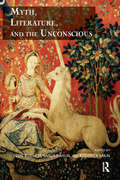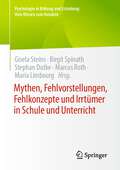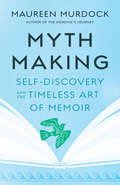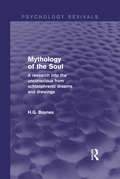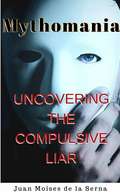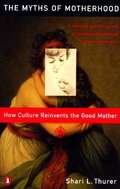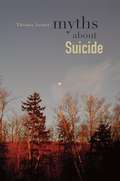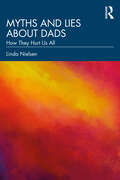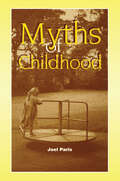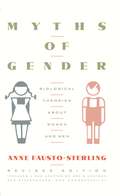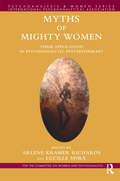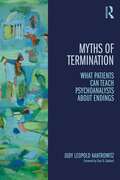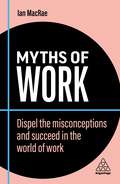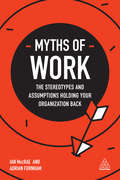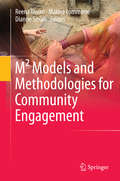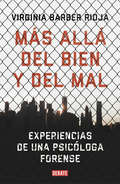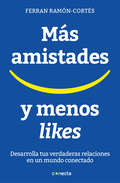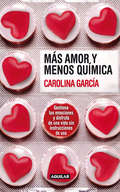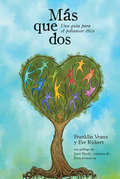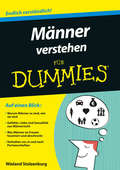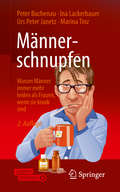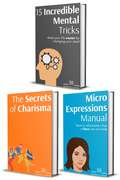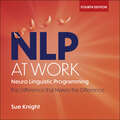- Table View
- List View
Myth, Literature, and the Unconscious
by Sanja Bahun Leon Burnett Roderick MainAt a time when the place and significance of myth in society has come under renewed scrutiny, Myth, Literature, and the Unconscious contributes to shaping the new interdisciplinary field of myth studies. The editors find in psychoanalysis a natural and necessary ally for investigations in myth and myth-informed literature and the arts. At the same time the collection re-values myths and myth-based cultural products as vital aids to the discipline and practice of psychoanalysis. The volume spans a vast geo-cultural range (including ancient Egypt, India, Japan, nineteenth-century France, and twentieth-century Germany) and investigates cultural products from the Mahabharata to J. W. Goethe's opus and eighteenth-century Japanese fiction, and from William Blake's visionary poetry to contemporary blockbuster television series. It encompasses mythic topics and figures such as Oedipus, Orpheus, the Scapegoat, and the Hero, while mobilising Freudian, Jungian, object relations, and Lacanian psychoanalytic approaches.
Mythen, Fehlvorstellungen, Fehlkonzepte und Irrtümer in Schule und Unterricht (Psychologie in Bildung und Erziehung: Vom Wissen zum Handeln)
by Marcus Roth Birgit Spinath Gisela Steins Stephan Dutke Maria LimbourgIn der Schule - wie in allen Lebensbereichen unserer Gesellschaft - existieren zahlreiche Mythen, Fehlvorstellungen, Fehlkonzepte und Irrtümer. In diesem Band gehen wir auf die Entstehung von Mythen, ihre Veränderungsmöglichkeiten und ausgewählte spezifische Mythen rund um Lehren und Lernen, aber auch auf Mythen wichtiger Themen des Sozialen im Schulkontext ein. Die Mythen, Fehlvorstellungen, Fehlkonzepte und Irrtümer werden aufbereitet, es wird beschrieben, worin der Mythos besteht, was Empirie und Theorie dazu zu sagen haben und wie die Mythen revidiert werden können. Konsequenzen für Schule und Unterricht werden herausgearbeitet. In diesem Band versammeln sich elf Beiträge, welche auf aktueller psychologischer Forschung beruhen und drei Themenkomplexe aufgreifen. Die ersten drei Beiträge des Bandes vermitteln Wissen zu der Frage, wie man Mythen erkennen kann, woher sie kommen und wie mit ihnen umzugehen ist. Diesem Themenkomplex folgen sieben Beiträge zu Mythen rund um das Lehren und Lernen sowie Themen des Sozialen im Schulkontext. Der den Band abschließende Beitrag richtet den Blick auf die Ausbildung der Lehrkräfte als einem dritten Themenkomplex. Die Beschäftigung mit dem Thema lohnt sich für alle Menschen, die erzieherisch und lehrend tätig sind. Das Thema ist nicht als Kritik an der Praxis am Lehrberuf zu verstehen, sondern als Anregung dafür, auf eigene Vorstellungen aus einer anderen Perspektive zu schauen und sich anregen zu lassen, die ein oder andere Praxis zu verändern.
Mythmaking: Self-Discovery and the Timeless Art of Memoir
by Maureen MurdockBest-selling Heroine&’s Journey author Maureen Murdock invites readers to explore their personal story within the rich tapestry of human experience by examining the craft of memoir alongside fresh writing advice and prompts.Maureen Murdock looks at thematic connections between ancient myths and contemporary memoirs to probe questions like: What is my journey? Where is home? Her background as a Jungian psychotherapist enriches her teaching—urging us to dig deep to identify our own universal archetypes.Writers who feel stuck or unworthy of writing about themselves will find thought-provoking inspiration and validation in this book, while those simply looking to use writing as a tool for self-exploration will examine their patterns and stories to reveal their true inner selves. And all will be left with a deeper understanding of the rich scope of the memoir genre by exploring contemporary favorites—like Terry Tempest Williams&’s Refuge, Joan Didion&’s The Year of Magical Thinking, and David Carr&’s The Night of the Gun—from a mythological perspective.Like myth, memoir reveals a unity to human experience that ultimately we all share similar hopes, dreams, and desires as well as fears, losses, and heartbreaks. Memoir helps writers understand the trajectory of their lives and helps readers better grasp our own place within the human experience.
Mythology of the Soul: A Research into the Unconscious from Schizophrenic Dreams and Drawings (Psychology Revivals)
by H.G. BaynesOriginally published in 1940, this classic study of two schizophrenic case-histories further opened up the seemingly intractable problem of this condition; a task preceded by Jung’s own Psychology of Dementia Praecox. It was Baynes’s grasp of the meaning of the symbol coupled with his wide scholarship that enable him to explore the case-histories in such remarkable and fruitful depth, thus linking pathological psychology through graphic expression and the dream of the myths of mankind and the universal man. This was truly a scientific task. In case 1, the series of dreams, fantasies and active imagination, fully illustrated by the patients’ spontaneous paintings, suggested to him a kind of mythological imagery. Baynes then demonstrates the emergence and development of a hero myth together with its therapeutic effect upon the patient, as an inner personal experience of death and rebirth. Baynes also applied the methods of synthesis to the understanding of modern art and its reflection of the spirit of the times – a realization of the basic split in the socio-religious structure of European Culture. In case 2, the subject was an artist, and out of his own split he seemed to have created a symbolic bridge that would be a therapeutic bridge for himself and a possible model for curing the evil of the times in which we then were living.
Mythomania, uncovering the compulsive liar.
by Juan Moises de la Serna Mario BolanosSometimes we find ourselves with people who tell us something that then turns out to be not true, that may not stop being an anecdote, but when lies are constant, we may be before a mythomaniac, that is, a person who lies almost compulsively, also known as a pathological liar. With this text you will learn what it is, how to differentiate it from other cases that show similar symptoms of lies and how to deal with this problem.
Myths Of Motherhood: How Culture Reinvents the Good Mother
by Sherry ThurerThis groundbreaking and irreverent history of motherhood is worth a hundred advice books for any mother who’s ever been made to feel guilty or frazzled by society’s impossible expectations. Analyzing data from the psychoanalyst’s couch to the hidden history of wet nursing, psychologist Shari L. Thurer wends her way from the Stone Age to the age of Hillary Rodham Clinton, painting a vivid, often frightening picture of life for mothers and children in a time when their roles were constructed by men. Along the way, she debunks myth after myth—exposing the not-so-golden ages of Classical Greece and the Italian Renaissance, and revealing the pervasive ideal of Dr. Spock’s selfless, stay-at-home mother as the historical aberration it actually was. A work of impassioned scholarship and astonishing range, The Myths of Motherhood does nothing less than recast our conception of good mothering.
Myths about Suicide
by Thomas Joiner<p>Around the world, more than a million people die by suicide each year. Yet many of us know very little about a tragedy that may strike our own loved ones―and much of what we think we know is wrong. This clear and powerful book dismantles myth after myth to bring compassionate and accurate understanding of a massive international killer. <p>Drawing on a fascinating array of clinical cases, media reports, literary works, and scientific studies, Thomas Joiner demolishes both moralistic and psychotherapeutic clichés. He shows that suicide is not easy, cowardly, vengeful, or selfish. It is not a manifestation of "suppressed rage" or a side effect of medication. Threats of suicide, far from being idle, are often followed by serious attempts. People who are prevented once from killing themselves will not necessarily try again. <p>The risk for suicide, Joiner argues, is partly genetic and is influenced by often agonizing mental disorders. Vulnerability to suicide may be anticipated and treated. Most important, suicide can be prevented. <p>An eminent expert whose own father's death by suicide changed his life, Joiner is relentless in his pursuit of the truth about suicide and deeply sympathetic to such tragic waste of life and the pain it causes those left behind.</p>
Myths and Lies about Dads: How They Hurt Us All
by Linda NielsenMyths and Lies About Dads: How They Hurt Us All is a groundbreaking book that destroys more than 100 of the most damaging beliefs about fathers. Using the most recent research, this pioneering work exposes these baseless beliefs and the toll they take on children’s relationships with their fathers, parents’ relationships with one another, and the physical and mental health of fathers and mothers. Tackling a wide range of topics from custody laws, to children’s toys, to the sexist behavior of counselors, pediatricians, and lawyers, Dr Linda Nielsen describes in vivid detail how these myths are linked to many of our most pressing issues: Creating more gender equity in childcare and housework Reducing child abuse, post-partum depression, and fathers’ suicide rates Expanding mothers’ and fathers’ options at home and at work Reducing children’s academic, behavioral, and emotional problems Lessening the pressures of parenting for both parents Changing sexist policies and practices that hurt parents and children Improving the economic situations for parents and their children The book is not only a wake-up call for parents but also for students and professionals in medicine and family law, social work, child development, education, and in the publishing, advertising, media, and entertainment industries. Above all, the book empowers parents to free themselves from the myths and lies about fathers that bind them.
Myths of Childhood
by Joel ParisChildhood has long been considered the major factor in determining adult life. It sets us on the path toward or away from happiness, shapes our personality, and is a major cause of mental disorders. Or is it?Myths of Childhood strongly challenges these assumptions usually taken for granted in contemporary society and the mental health community. With a healthy dose of scepticism toward clinical impressions and using empirically-based research from areas including behavioral genetics and attachment, Dr. Paris builds a convincing case against the primacy of childhood in the development of adult personality and psychopathology. In its place, he offers an alternative model for development and shows how mental health professionals can apply this model to clinical pracitce.Myths of Childhood represents an important addition to the ongoing debate between mental health professionals regarding nature vs. nurture. For supporters of either side , this book is a valuable resource for further exploration of this controversy.
Myths of Gender: Biological Theories about Women and Men
by Anne Fausto-SterlingBy carefully examining the biological, genetic, evolutionary, and psychological evidence, a noted biologist finds a shocking lack of substance behind ideas about biologically based sex differences. Features a new chapter and afterward on recent biological breakthroughs.
Myths of Mighty Women: Their Application in Psychoanalytic Psychotherapy (Psychoanalysis and Women Series)
by Arlene Kramer RichardsWomen whose mothers were not called upon to achieve in a man's world have a difficult time seeing themselves as powerful enough to do that. Identifying with mighty women of the past and of the present culture can help them to permit themselves to achieve more than their mothers did. This book provides several such myths from ancient and modern cultures, from both Western and Eastern traditions, each of which is a standard for a particular aspect of female power and all of which can provide that power for women now. Among the aspects of women's power are Super Girl, Warrior Woman, Evil Temptress, Protective Mother and Provider. This book is useful for therapists to read themselves and/or to give to their patients when they suffer from fantasies of the bad mother who does not want to be surpassed or the weak mother who cannot protect, or the therapist who wants to keep the woman patient in a weak and needy position.
Myths of Termination: What patients can teach psychoanalysts about endings (Psychological Issues)
by Judy Leopold KantrowitzPsychoanalysis can make a huge difference in the lives of patients, their families and others they encounter. Myths have developed, however, about how psychoanalysis should end – what patients experience and what analysts do. These expectations come primarily from accounts by analysts in the analytic literature which are often perpetuated in an oversimplified form in teaching. Patients' perspectives are rarely presented. I her book, Judy Leopold Kantrowitz seeks to address this omission. Exploring the accounts of 82 former analysands, she illustrates the rich diversity of psychoanalytic endings and ways of maintaining analytic benefits after ending; in presenting patients' experiences Kantrowitz provides correctives for some myths about termination. Myths of termination: What patients can teach psychoanalysts about endings is not a book that seeks to refute or support any specific idea about a best way of ending analysis, but rather to show that there are countless ways of having a satisfactory conclusion to the process. Nor is the author espousing any particular analytic theory. Kantrowitz sets out to show that an oversimplified view of psychoanalytic endings not only diminishes an appreciation of the diversity of psychoanalytic outcomes but may also interfere with the creativity of individual psychoanalysts. In this book, former analysands describe and illustrate how their analyses ended. They reflect on the effect of non-mutual endings due to external factors (moving, retirement, illness or death) or psychological factors (wishing to avoid facing some issue); the impact of post-analytic contact; and the ways in which they have held on to their analytic benefits after ending their analyses. Myths of termination confronts and refutes the myths about the termination phase of psychoanalysis that are passed from generation to generation. It is a refreshing and insightful study that will be welcomed by psychoanalysts, psychodynamic therapists, such as clinical psychologists, social workers, and others trained or in training to do clinical work.
Myths of Work: Dispel the Misconceptions and Succeed in the World of Work (Business Myths)
by Ian MacRaeBuying a table tennis table will make your staff happier. Working eight hours a day, five days a week, will result in the most productivity. Paying higher salaries will always result in higher motivation. But will it really?There are a staggering number of myths, stereotypes and out-of-date rules that abound in the workplace. This can make it feel impossible to truly know how to get the most out of your career, your team and your company. In Myths of Work, Ian MacRae take an entertaining and evidence-based look at the most pervasive myths about our working lives, from the serious to the ridiculous, to give you the insight you need to become a better manager in the modern workplace. Fascinating real life case studies from organizations around the world display the myths (and how to overcome them) in practice.Myths of Work combines business thinking with psychology to give you practical insights, a lively writing style and a handy dip-in-and-out structure to form your ultimate guide to becoming a better and enlightened manager.About the Business Myths series...The Business Myths series tackles the falsehoods that pervade the business world. From leadership and management to social media and the workplace, these accessible books overturn out-of-date assumptions, skewer stereotypes and put oft-repeated slogans to the myth-busting test. Both entertaining and rigorously researched, these books will equip you with the insight and no-nonsense wisdom you need to succeed.
Myths of Work: The Stereotypes and Assumptions Holding Your Organization Back
by Adrian Furnham Ian MacraeBuying a table tennis table will make your staff happier. Working eight hours a day, five days a week, will result in the most productivity. Paying higher salaries will always result in higher motivation. But will it really?There are a staggering number of myths, stereotypes and out-of-date rules that abound in the workplace. This can make it feel impossible to truly know how to get the most out of your career, your team and your organization. In Myths of Work, Ian MacRae and Adrian Furnham take an entertaining and evidence-based look at the most pervasive myths about our working lives, from the serious to the ridiculous, to give you the insight you need to become a better manager in the modern workplace. Fascinating real life case studies from organizations around the world display the myths (and how to overcome them) in practice.Myths of Work takes the most up-to-date academic research in business and psychology and combines it with practical insights, a lively writing style and a handy dip-in-and-out structure to form your ultimate guide to becoming a better enlightened manager.
M² Models and Methodologies for Community Engagement
by Dianne Smith Marina Lommerse Reena TiwariHow can we engage communities? What is empowerment? To what extent should the project process be participatory? How is an outsider-insider relationship handled? How do researchers negotiate with the hegemony of western cultural interpretations? How are organizational and contextual influences handled in a project? What leadership demands do such projects place on researchers? What is capacity building? What are creative leaders and creative communities? How does the researcher journey from their studio to the situation? M² Models and Methodologies for Community Engagement discusses key theoretical constructs -- community engagement, capacity building, and community empowerment -- in order to demonstrate how theory and practice are relevant to the development of forms of community involvement. The book maps the attributes of community based projects by moving beyond simply bringing people together from a variety of disciplines, and taking an approach which is transdisciplinary and applicable across cultures and genres. Here, all people -- including the community -- are ongoing contributors, and can freely move between their own and others' discipline-specific arenas. M² differs from and extends on other works in this field of practice and research, in that its transdisciplinary, collaborative approach positions the community as a particular kind of discipline to create real change in diverse locations and fields of experience. The book is in itself a model of community engagement, as the researchers have formed a community of research and practice for change, and have developed a transformative model for community engagement that is greater than the sum of its parts - hence M². M² offers a valuable resource for students, researchers, academics, practitioners, policy developers and volunteers from the fields of architecture, interior architecture, health, planning, anthropology, education, home economics, communication, political studies and development studies.
Más allá del bien y del mal: Experiencias de una psicóloga forense
by Virginia BarberLa doctora Barber nos descubre que el mal tiene un rostro dolorosamente humano. «Al llegar, Henry seguía allí. Me dejaron entrar a verlo. Estaba sentado en la celda, vestido de naranja, con las manos esposadas por delante y cabizbajo. Cuando oyó mi voz levantó la cabeza; aunque estaba llorando parecía aliviado de verme. Se levantó. Los guardias me gritaban: "¡Doctora, no lo puede tocar, ya no es su paciente, es un preso! ¡No se acerque, tiene treinta segundos!". Fui capaz de meter mis manos entre los barrotes y tocar las suyas unidas por las esposas. "Recuerda lo que hemos hablado, espero no tener que volver a verte." Fueron las últimas palabras que le dije y la última vez que lo vi.» En Más allá del bien y del mal Virginia Barber Rioja nos cuenta mediante unas excepcionales memorias sus experiencias como psicóloga forense. El enfoque de esta joven canaria establecida en Nueva York nos abre los ojos frente a los riesgos de un sistema penitenciario que no contempla las condiciones sociales ni las necesidades básicas de reclusos con enfermedades mentales y explica el rol fundamental de sus compañeros de profesión para incidir en la creación de una ley más humana y más justa que nos permita avanzar hacia una sociedad mejor.
Más allá del bien y del mal: Experiencias de una psicóloga forense
by Virginia BarberLa doctora Barber nos descubre que el mal tiene un rostro dolorosamente humano. «Al llegar, Henry seguía allí. Me dejaron entrar a verlo. Estaba sentado en la celda, vestido de naranja, con las manos esposadas por delante y cabizbajo. Cuando oyó mi voz levantó la cabeza; aunque estaba llorando parecía aliviado de verme. Se levantó. Los guardias me gritaban: "¡Doctora, no lo puede tocar, ya no es su paciente, es un preso! ¡No se acerque, tiene treinta segundos!". Fui capaz de meter mis manos entre los barrotes y tocar las suyas unidas por las esposas. "Recuerda lo que hemos hablado, espero no tener que volver a verte." Fueron las últimas palabras que le dije y la última vez que lo vi.» En Más allá del bien y del mal Virginia Barber Rioja nos cuenta mediante unas excepcionales memorias sus experiencias como psicóloga forense. El enfoque de esta joven canaria establecida en Nueva York nos abre los ojos frente a los riesgos de un sistema penitenciario que no contempla las condiciones sociales ni las necesidades básicas de reclusos con enfermedades mentales y explica el rol fundamental de sus compañeros de profesión para incidir en la creación de una ley más humana y más justa que nos permita avanzar hacia una sociedad mejor.
Más amistades y menos likes
by Ferran Ramón-CortesInmersos en las redes sociales, estamos más conectados que nunca a muchas personas y más desconectados que nunca de todas. Es hora de recuperar el control sobre nuestras relaciones y de ordenarlas para cuidar las que de verdad nos importan y deshacernos de las que nos sobran. Está en juego nuestra felicidad porque las relaciones personales hacen que seamos más o menos felices. Somos la generación de las redes sociales y nos relacionamos con más personas que nunca, aunque pagamos un precio muy alto por ello. Comenzamos respondiendo wasaps mientras cenamos con los amigos o aplazando indefinidamente encuentros y salidas con personas a las que queremos, y acabamos secuestrados por contactos inútiles, e-mails y mensajes de todo tipo y estilo. En el mejor de los casos, nos sentimos desbordados. En el peor, no tenemos tiempo para cuidar aquellas relaciones que más nos importan. Por eso ha llegado el momento de recuperar el control sobre nuestras relaciones y de ordenarlas para preservar y cuidar las más valiosas. Y para ello tendremos que asumir que no podemos llevarnos bien con todo el mundo ni mantener una relación intensa con muchas personas a la vez, y aceptar que las relaciones a veces se desgastan, mueren o, en ocasiones, renacen. Y debemos ponernos manos a la obra de inmediato porque, aunque ya sabemos que ni el éxito ni el dinero garantizan la felicidad, sí se ha demostrado que las relaciones personales hacen que unas personas sean más felices que otras.
Más amor y menos química
by Carolina GarcíaGestiona tus emociones y disfruta de una vida sin instrucciones de uso. El consumo de psicofármacos aumenta en nuestro país de manera alarmante. La facilidad con la que los médicos los prescriben, la automedicación, la búsqueda de una solución a los problemas rápida y eficaz son factores que potencian esta nueva realidad. Lo cierto es que el origen de trastornos como la ansiedad, la depresión o el estrés está más relacionado con la carencia de afecto, las emociones o los pensamientos que con las dolencias físicas, y que la ingesta continuada de medicamentos no resuelve estas enfermedades, sólo las acalla o las simula. Las consecuencias en cambio son evidentes: nos transformamos en seres perezosos, incapaces de tomar las riendas de nuestra vida, en fabricantes de objetivos superficiales a corto plazo y no de felicidad. En Más amor y menos química la psicóloga Carolina García nos ayuda a descubrir las propiedades terapéuticas de la afectividad y los sentimientos, su papel en nuestra vida, así como las consecuencias de sus carencias. Nos informa de los peligros de los antidepresivos, nos descubre terapias alternativas como la risoterapia, la musicoterapia, la homeopatía y nos enseña a trabajar la autoestima, el sentido del humor o la relajación para amarnos a nosotros y a quienes nos rodean. Una obra imprescindible para ser feliz sin química sólo con amor.
Más que dos: Una guía para el poliamor ético
by Franklin Veaux Eve RickertEl libro More Than Two se publicÓ en el aÑo 2014 y pronto se convirtiÓ en un referente del poliamor, ya que se centra en exclusiva en este tipo de relaciones y ofrece multitud de casos prÁcticos y consejos Útiles para su buen funcionamiento. MÁs allÁ de la pareja es la guÍa mÁs reciente sobre poliamor Ético. En sus 25 capÍtulos, los autores van y vienen de la teorÍa a la prÁctica. Eve Rickert y Franklin Veaux han recogido a lo largo de 20 aÑos sus experiencias y las de cientos de miembros de la comunidad poliamorosa norteamericana. Este manual es una herramienta Útil tanto para las personas que estÁn empezando a pensar sus relaciones de forma poliamorosa como para quienes viven el poliamor desde hace tiempo y quieren encontrar ideas, reflexiones e historias de personas que han buscado relacionarse emocionalmente de forma Ética y no monÓgama durante aÑos. Los autores abordan los cuidados, las negociaciones, el veto, los derechos de las personas que tienen una relaciÓn con alguien que ya tiene pareja, las jerarquÍas en las relaciones y si estas tienen sentido, la confianza, el empoderamiento, los celos, la honestidad y la comunicaciÓn en relaciones no monÓgamas. Este libro no solo derriba los mitos de la monogamia, tambiÉn algunos de los mitos de las relaciones no monÓgamas, Eve Rickert y Franklin Veaux nos invitan a cuestionar desde dÓnde decidimos querernos, escriben sobre el riesgo, el miedo y el crecimiento. No es posible abrirse al poliamor si no queremos habitar nuestra vulnerabilidad y no es posible amarnos sin asomarnos radicalmente a las necesidades y deseos de aquellas personas con las que caminamos.
Männer verstehen für Dummies (Für Dummies)
by Wieland StolzenburgErfahren Sie, wie Männer »ticken« Warum sind Männer so, wie sie sind? Warum tun sich viele schwer mit festen Bindungen und welche Hürden gibt es auf dem Weg zu einer langfristigen Partnerschaft? Warum ist Sex für sie so wichtig? Wie gehen Männer mit Ängsten und Schwächen um und warum brauchen sie Anerkennung, Macht und Kontrolle? Wieland Stolzenburg führt Sie in die männliche Gefühlswelt ein, analysiert, wie Männer sich vor, in und nach Beziehungen verhalten, welche Rolle Hobbys und Karriere in ihrem Leben spielen und zeigt, wie die Beziehung zu einem Mann gelingen kann. Wissenschaftlich fundierte Hintergrundinformationen und konkrete Tipps zum Umgang mit dem vermeintlich starken Geschlecht machen das Buch zu einem wertvollen Ratgeber.
Männerschnupfen: Warum Männer immer mehr leiden als Frauen, wenn sie krank sind
by Peter Buchenau Ina Lackerbauer Urs Peter Janetz Marina TinzIn diesem Buch finden Sie alle Antworten darauf, warum bei Männern eine Erkältung nicht einfach nur eine Erkältung ist und sie stets denken, todsterbenskrank zu sein, auch wenn es ein einfacher Schnupfen ist. Haben Sie sich schon einmal gefragt, warum das so ist? Wir erklären es Ihnen: wie sich das Verhalten von Männern und Frauen generell unterscheidet, ob die Rollenbilder einen Einfluss auf das Phänomen des Männerschnupfens haben, warum Erkältungen von Männern und Frauen unterschiedlich wahrgenommen werden, warum Männer extrem und irrational besorgt sind, wenn sie krank werden, wie Frauen Schmerzen wahrnehmen. Augenzwinkernd und charmant formuliert - eine Ode an die neue Männlichkeit: der Schrei nach Aufmerksamkeit. Leidensszenario, Hausmittel und Therapievorschläge inklusive. Als besonderes Extra enthält die 2. Auflage Ausschnitte aus dem Männerschnupfen-Bühnenprogramm sowie ein Koch-Video.
NLP Collection and Social Tricks
by Danilo H. GomesMany people suffer from not having a good quality social life. In addition to this, they feel the need to evolve some mental abilities. We all want to evolve our capabilities and our resourcefulness in society. With the right tools, we can achieve these goals. The NLP AND SOCIAL TRICKS COLLECTION brings together 3 books that address topics such as: neurolinguistic programming, psychology, body language, social techniques and self-help.
NLP Workbook: Teach Yourself
by Judy BartkowiakDo you want to use the power of NLP to supercharge every aspect of your life? Do you want to understand how to create instant rapport with anyone? Do you want to be able to effectively emulate the skills of the people you respect the most? This new Teach Yourself Workbook doesn't just tell you how to use NLP. It accompanies you every step of the way, with diagnostic tools, goal-setting charts, practical exercises, and many more features ideal for people who want a more active style of learning. The book starts by helping you identify your own preferred styles of learning and communication. It then helps you set specific goals to improve on; as you progress through the book, you will be able to keep checking your progress against these goals. Specially created exercises, using the tools and techniques of NLP, will help you boost your skills and communication so that you can reach your potential in any situation.
NLP at Work: 4th Edition: The Difference that Makes the Difference
by Sue Knight'This book may help you to understand life more clearly' Paul Smith, fashion designerWelcome to THE book on NLP. The essence of NLP is the ability to study and reproduce excellence in yourself and to support others to do the same. NLP AT WORK helps you do that by developing an attitude of curiosity, naivety and learning - and giving you the ability to improvise with skill in real-time. Neuro Linguistic Programming is how you make sense of your world and, most importantly, how you make it what you want it to be: * Neuro: the way you filter and process your experience through your senses. * Linguistic: the way you interpret your experience through language. * Programming: the way you make sense of your experience to create your personal programme. NLP AT WORK is one of the most popular books ever published on the practical skills of NLP and how it can be applied in business. It transformed NLP from a peripheral art into an accessible, practical concept with relevant applications in the areas of influence, communication, negotiation, teamwork and coaching. Clear, readable and jargon free, this book will help you get to the essence of what makes you and your business excellent and unique.(P) 2020 Hodder & Stoughton Ltd
